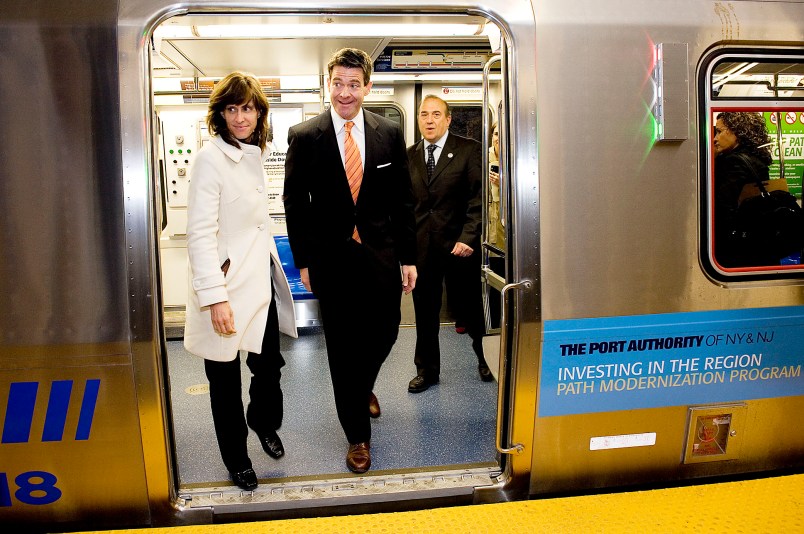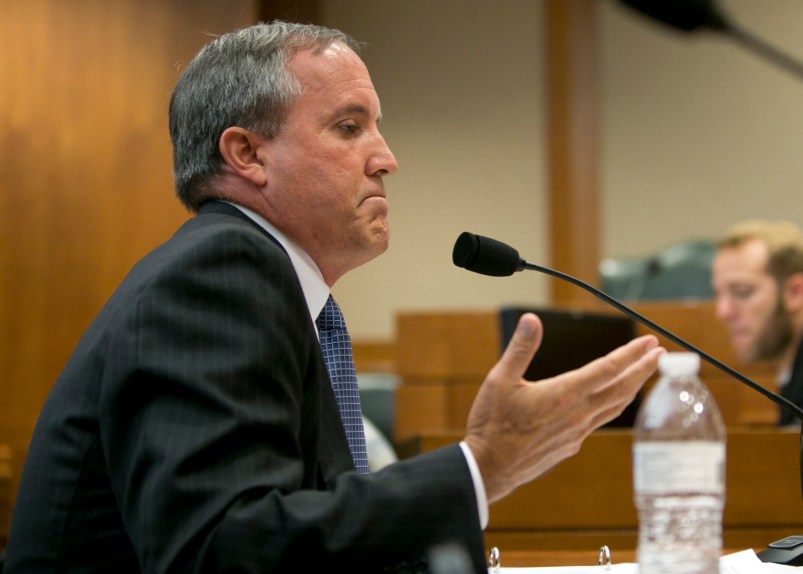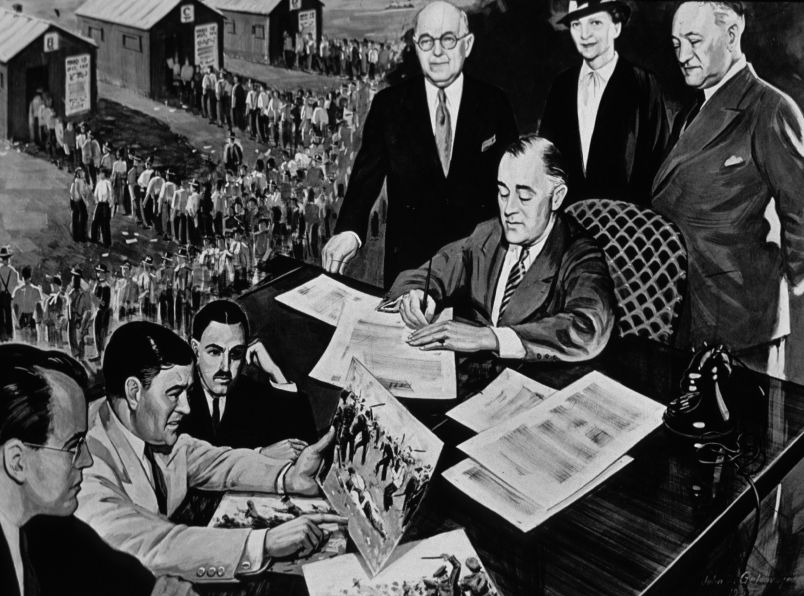On MSNBC’s “Up with Steve Kornacki” this morning, Hoboken, N.J. mayor Dawn Zimmer offered an extraordinary account of her dealings with the administration of Governor Chris Christie concerning federal Hurricane Sandy relief aid. She described an effort by top state officials – the lieutenant governor and a cabinet member – to coerce Hoboken’s city government into fast-tracking approval of a proposed redevelopment project by withholding Sandy aid from the government and residents of her city. That project, she says she was told, was “very important to the governor.” And if she worked to get it approved, “the money would start flowing to you.”
It just so happens that the proposed project in question is situated on three blocks of land owned by the Rockefeller Group, a client of the law firm of Wolff & Samson. That firm was founded by Christie confidante David Samson, a former state attorney general who Christie tapped to head his transition team in 2009. In 2011 the governor appointed Samson to become the chairman of the Port Authority of New York and New Jersey, where he remains today.
This is a riveting narrative, and I encourage you to watch Steve’s introduction at the top of the show and his interview with Mayor Zimmer. Steve and I have been collaborating and reporting and trying to make sense of this for more than a week. The package itself was put together with an extraordinary amount of shoe-leather and hard work by Kornacki and staff, including TPM alum Eric Kleefeld. During the second hour of the show, Steve asked for analysis and context from a panel that included me – a former political reporter in New Jersey and a Baruch College – CUNY history professor who studies the intersection of economics and politics.
Both Steve and I have personal ties to individuals involved in the recent stories coming out of New Jersey, and we’ve been collaborating to make sense of recent revelations, including but not limited to those involving the now-infamous lane closures at the George Washington Bridge that were undertaken at the behest of aides to Governor Christie and his appointees at the Port Authority. We proposed a theory about those September lane closures involving a redevelopment project that was discussed on MSNBC last week and which I later wrote up for TPM.
You may have already seen Mayor Zimmer in the news this week. Hoboken received only 1% of the aid they had requested for Hurricane Sandy relief and planning funds even though it was one of the hardest-hit communities in the state during the storm. At one point, 80% of the 50,000 person city was flooded. If you remember the footage of water gushing through an underground subway station, that was in Hoboken; it has, in fact, the highest per-capita use of public transit of any city in America. Yet so far the state of New Jersey has given the city about $350,000 from the billions of dollars in federal disaster relief and planning aid that it is charged with administering. That’s about $6 per resident. It has been enough to pay for one major planning study and to buy one backup generator for an $18 million emergency storm water pump.
50,000 people. 80% flooded. $6 a head.
News outlets and the mayor have both wondered if the anemic aid was a punishment for Zimmer not endorsing the governor’s reelection bid. Mayors in Jersey City, Elizabeth, and other New Jersey municipalities have been asking the same question since Fort Lee mayor Mark Sokolich raised the possibility that his refusal to endorse Christie led to the lane closures on GWB and the four-day-long traffic nightmare in that town.
This Hoboken story and the Fort Lee/GWB story might seem like separate tales. But they’re not. Moreover, these latest revelations put to rest the notion that Hoboken’s Sandy aid or the Fort Lee/GWB story have anything to do with local Democratic officials’ endorsement of the governor during his reelection campaign. Forget about the endorsements. It never really added up anyway.
The subpoenaed documents in Bridgegate show that the Christie administration used the Port Authority as an extension of their political operation, although we do not yet know to what end.
And the Hoboken story clearly demonstrates the Christie administration took steps to aid the material interest of a client of the chairman of that agency.
Here’s what happened:
In June 2010 a member of the governor’s cabinet, Lori Grifa, the commissioner at the Department of Community Affairs, encouraged the city of Hoboken to apply to the Port Authority for a grant that would fund a study to determine whether a nineteen-block neighborhood in the northern corner of the town should be classified as suitable for “redevelopment.” That’s the same neighborhood where the Rockefeller Group bought three blocks in 2008.
You may not realize it, but “redevelopment” is a technical term – a legal trigger that can shower a project with goodies like tax abatements, tax credits, grants, and vest local governments with sweeping powers to issue bonds, take properties in the affected area by use of eminent domain, and re-zone an area to suit just one developer’s interests and needs (you can find more by looking up N.J.S.A. 40A:12A-8).
If it sounds like a city might be tempted to grant itself this power to help out a mayor’s buddy, you’d be right. Think back to the blight ordinances that were used to clear-cut neighborhoods in the 1960s and 70s to make way for stadiums and concentrate poor minorities in towering public housing projects. Recall what Robert Moses did to make way for the Cross Bronx Expressway, carving vital neighborhoods in two and plowing through people’s homes.
That history – that blighted history – is why today there is a clear process for determining when and how redevelopment authority may be granted. It’s an imperfect process, to be sure, but one that has evolved through experience to provide some modicum of fairness to the stakeholders in a town who could be adversely affected by a redevelopment project.
In the case of Hoboken, those stakeholders were the owners of those nineteen blocks on the north end of town, along with the rest of the city’s residents. When city officials, including mayor Zimmer, met with Port Authority deputy executive director Bill Baroni to discuss the city’s relationship with the Port, they talked about a program called the Local Assistance Program (LAP). It’s a fund of about $300,000 to $500,000 that’s annually disbursed to cities and counties within the “port district” of the authority’s jurisdiction. (There was actually a mention of a LAP grant in one of David Wildstein’s messages to Bridget Kelly.)
Now let’s remember: the Port Authority is a big bi-state agency.
How big?
Let me tell you: They manage the New York City airports: JFK, EWR, LGA. They manage the George Washington Bridge, the Lincoln Tunnel, the Holland Tunnel, the Goethals Bridge, the Outerbridge Crossing. They mange the World Trade Center. In their 2012 financials, it shows they have an operating budget of $2.5 billion. They have an investment portfolio that was worth $5.45 billion last June. They’ve got $3 billion in infrastructure projects in the pipeline and plan to spend $25 billion more in the next decade. They write $750 million in contracts a year. They do big deals, they give out a lot of work, and they have the power to make people very very rich.
In the scheme of the Port Authority’s operations, a $75,000 grant for a planning contract just doesn’t attract any attention. And why should it? The city applies for it as a way to defray the costs of doing something like a traffic study or a redevelopment study. The Port awards the contract through a bidding process that seems fairly transparent. The study gets done, the recommendations are accepted, and a project moves forward. Just like any other grant process that a municipal government goes through every month.
So Hoboken’s contract was awarded to a firm called Clarke Caton Hintz. They do lots of work with agencies and municipalities in New Jersey. Hoboken seemed happy with their selection in 2011.
Months passed. Then a year. Sandy happened, and everything was put on hold.
But in early 2013 the study was completed and Hoboken officials were surprised by what they saw: of the nineteen block studied on the North End, only three were deemed eligible for redevelopment. And they were all owned by the same entity: the Rockefeller Group.
Zimmer already had dealt with the Rockefeller Group since becoming mayor in 2009. The firm had publicized a major redevelopment “vision” centered around a 40-story office tower. In a 2010 Newark Star Ledger article the company nudged Zimmer toward offering them support by reminding people that past mayors had done the same. They said they were “working with Mayor (Dawn) Zimmer…to bring tax relief, jobs, economic benefits, and recreation to Hoboken residents.” But Zimmer was firm in following the process by the book. “There have been no negotiations with the Rockefeller Group,” she said, and there would be “no negotiations until a study has been completed, and a public process including all residents and property owners has been completed in order to determine what kind of development our city would like to have in that area.”
Well in 2013, that study was done. It was the one funded by the Port Authority’s LAP grant, the one recommending that – of all 30 acres in the North End – the only blocks that met the qualifications for redevelopment designations were the three owned by the Rockefeller Group.
During the weeks before Hoboken’s planning board was set to decide whether or not to endorse that conclusion, Hoboken officials heard from Lori Grifa again. Only this time she wasn’t calling as the commissioner at the Department of Community Affairs; she was calling as the lawyer representing the Rockefeller Group from the firm of Wolff & Samson, where she heads the firm’s regulatory affairs unit. Grifa left the cabinet in 2011, and under state rules she wasn’t allowed to do lobbying work for a year afterwards. So in 2013 it was fine for her to lobby on behalf of a client regarding a grant she arranged while she was in public service – a grant that came from the agency chaired by the head of her firm.
But there was something about the way Grifa was reaching out to Hoboken that set off an alarm bell. She wanted to talk with the city’s planning attorney by phone, and she let it be known David Samson would also be on the call. “I am getting the full court press on this,” the attorney wrote, to talk with “Lori and Dave Samson (chair of the PA).” Worse yet, there was no agenda provided beforehand.
The attorney was uncomfortable, and why wouldn’t he be? Grifa had asked him to take an open-ended meeting with the chairman of the Port Authority. The power dynamic could not have been more asymmetrical. Could you really afford, as a planning attorney in any town in New Jersey, to say no to the chairman of the Port Authority?
More emails followed, with the subject line “Hoboken/Rockefeller Group.” Each was cc’d to David Samson. Lori Grifa said that since the “blight study” had been “published” she needed to talk about the “next steps in Hoboken” and get the city ready to “plan for the same.”
Never mind that the study had not yet been recommended by the city’s planning board. Grifa was “assuming adoption” and wondering how the city would “move from the Study to the Redevelopment Phase.” She wanted to know if Clarke Caton Hintz would be retained. She sought “time frames.”
But then the Hoboken planning board turned down the study’s recommendation. The owners of the other sixteen blocks had banded together, hired their own lawyer, and filed an objection to the study’s conclusions. Calling themselves “the Other North End Property Owners,” they wrote that it was an “obvious” that “the Study’s myopic recommendation favors a particular property owner.” They asked why “a redevelopment plan for the exclusive benefit” of the Rockefeller Group would “[favor] a single property owner to the detriment of all other property owners in the North End Area.” Their argument won the day
That happened on May 8. But although Rockefeller lost the round, it wasn’t a binding decision. The planning board only makes recommendations to the city council. In other words, everything was still in play.
Remember that this is May 2013. Sandy grants were being awarded, applications were being filed, and Hoboken was asking for almost $100 million in aid to recover from the hurricane’s damage and plan for future storms. The city had a lot at stake.
On May 13 Mayor Zimmer hosted a VIP guest in Hoboken: New Jersey Lieutenant Governor Kim Guadagno, who was in town to attend a local grocery store opening and talk Sandy relief. At one moment during the event, the mayor claims, Guadagno pulled her aside and started talking about…the Rockefeller Group project.
The project, Guadagno said, was “very important to the governor,” and the perception was that the mayor opposed it. Unless Zimmer used her influence to “move forward,” the Christie administration was “not going to be able to help you” on Sandy aid. According to a diary entry Zimmer made following this meeting, the lieutenant governor told her, “I know it’s not right – these things should not be connected – but they are.” Zimmer wrote that Guadagno told her she would deny ever having said this if asked later, not realizing that the Hoboken mayor keeps a written diary.
Then on May 16, the following Saturday, Zimmer was at Monmouth University for an NJTV public television event on Sandy relief. She found herself sitting with Richard Constable, a former assistant U.S. Attorney who worked in Chris Christie’s office when Christie was U.S. Attorney for New Jersey, and who was subsequently named commissioner of the Department of Community Affairs to succeed Lori Grifa.
With microphones attached – and, according to Zimmer, audio technicians able to listen in – Constable delivered a message that echoed the one delivered by Lieutenant Governor Guadagno. In a diary entry made the next day, May 17, Zimmer wrote that Constable said, “I hear you are against the Rockefeller project.” The mayor said she was not. “Oh really?” Constable asked in reply. “Everyone in the State House believes you are against it – the buzz is that you are against it.”
According to Zimmer, he added: “If you move that forward, the money would start flowing to you.”
In her diary entries following the encounters with Guadagno and Constable, Zimmer expresses dismay – I don’t think there’s any better word for it really. She sees the governor as no different from everyone else: “cut from the same corrupt cloth that I have been fighting for the last four years.” See it for yourself at MSNBC’s website.
Dawn Zimmer and Chris Christie had a connection. She had become mayor of Hoboken because her predecessor, Peter J. Cammarano, had been arrested 22 days after being elected in mid-2009.
What was Cammarano’s crime? He had promised to speed a development project in exchange for a $25,000 bribe and was pinched along with 28 other politicians in a sting that nabbed 60 people altogether. The crimes ranged from bribery to offering to expedite development to trafficking in human organs (yes, really).
Chris Christie ran that sting operation, and Dawn Zimmer loved his work as a U.S. Attorney who prosecuted corrupt local officials in New Jersey, a record that he used to launch his bid to win election as governor in 2009. When Christie did his first town hall event as governor, he did it in Democratic Hoboken. And Dawn Zimmer, the new Democratic mayor was there to greet him.
Today, however, the onetime admirer is accusing his lieutenant governor and a member of his cabinet of trying to get her to do what Cammarano had done. To move things along. To interfere with the process.
We don’t know if the governor knew about this. We don’t know if David Samson knew about this. But someday we will. Just like we’ll figure out what happened at the bridge.
We will figure it out because we have seen this before. One of the keys to understanding American politics – or any politics, really – is that power and influence reside in places where you might not think it obvious to look. Robert Moses wielded power in New York City for half a century, but he didn’t do it from an elected office. As Robert Caro reminds us in The Power Broker – a Bible to understanding American politics – “we’re taught that in a democracy power comes from being elected.” But “Robert Moses wasn’t elected to anything” and “he had more power than anyone, and he held it for 48 years.”
Was the governor telling his aides to act on David Samson’s client’s behalf? Or did they just know to do so? Were they so attuned to the power dynamic between the state and the Port Authority, an agency that’s putting $1.5 billion into New Jersey projects, that they thought they had no choice but to do a favor for the agency’s chairman. Those projects, after all, are filling critical holes in New Jersey’s state budget. The Port Authority’s work is therefore taking a problem off the governor’s hands as he explores higher office (see WNYC Andrea Bernstein’s must-read/listen story fromThursday).
We like to think that agencies like the Port Authority, a 92-year-old agency, are subordinate to the states that created them. But it doesn’t seem that way right now, does it? The Port looks more like a state within a state, imperium imperio. Its independence makes it more likely to behave politically, less accountable to elected officials, and less transparent to the public. We know that from reading the documents that have been released in connection with the N.J. Assembly’s investigation. It is entirely possible that the Port Authority has become the Triboro Bridge Authority of our era, managed by political entrepreneurs who are too powerful to offend, running a portfolio too big to oversee. No wonder the Christie administration decided, early on, to begin packing it with their own appointees and dependents.
It’s time to retire hashtag headline word “Bridgegate.” The term doesn’t even begin to scratch the surface.
Brian Murphy (@burrite) is a former political reporter in New Jersey and now an assistant professor of history at Baruch College, where he studies political economy and the politics of banking and infrastructure in the early American republic. He worked for David Wildstein in 2002 as the managing editor of PoliticsNJ.com and is also a friend of Bill Baroni. Both men are intimately involved in the scandal. He has not spoken with either about the scandal. He has never met Wildstein in person, and has not seen Baroni since 2009.










